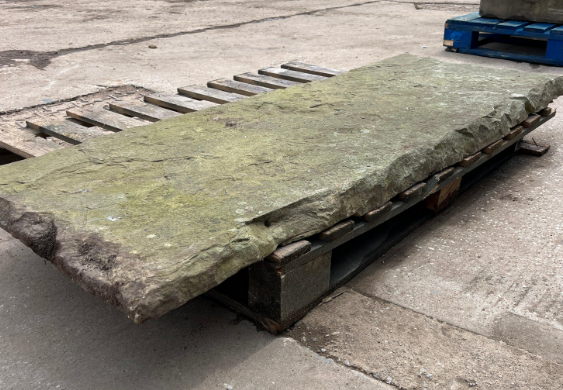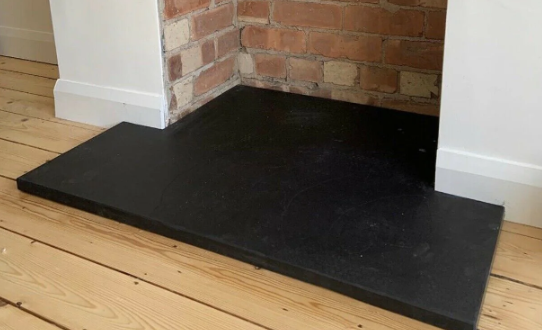Choosing the Best Hearth for Solid Fuel Fires: A Comprehensive Guide: The hearth is a crucial element in starting a solid fuel fire since it not only guarantees safety but also improves the appearance of your living area. A well-designed hearth enhances the fireplace and has a big impact on the room’s atmosphere. You can use this blog to learn which hearth options are optimal when utilizing solid fuels like wood, coal, or pellets.
Realizing How Important a Hearth Is
The non-combustible floor space right in front of a fireplace is called a hearth. Its main duties are:
–Safety: Keeping embers and sparks from setting adjacent carpets or rugs on fire.
–Protecting the floor from the fire’s extreme heat is known as heat protection.
–Aesthetic Value: enhancing the fireplace’s visual appeal.
Best Hearth Material for Slate Fires with Solid Fuel Advantages:
Slate
–Durability: Slate is extremely resilient to heat-induced breaking.
–Look: Provides a rustic, natural appearance with color and texture variances.
–Maintenance: It’s a sensible option for hectic homes because it’s simple to clean and maintain.
Cons:
–Weight: Because slate can be hefty, considerable structural support is needed.
–Cost: Compared to other options, this one may be more expensive, particularly for high-quality items.
Granite
–Heat Resistance: Outstanding ability to resist high heat unharmed.
–Variety: Offers design versatility in a broad spectrum of hues and patterns.
–Durability: Extremely impervious to stains and scratches.
Cons:
–Cost: Usually more costly, but because of its duration, the investment is beneficial.
–Installation: Because of its weight and the requirement for exact cutting, it requires professional installation.
Marble:
–Aesthetic Appeal: Enhances the décor of any place with an opulent and refined appearance.
Capable of withstanding the elevated heat caused by fires burning solid fuel.
Cons:
–Maintenance: Requires regular sealing to prevent staining and damage from soot and ash.
–Cost: Generally more expensive and can be prone to scratching and etching.
Limestone
–Natural Beauty: Offers a range of subdued color selections with a delicate, natural appearance.
–Heat Resistance: Capable of withstanding the heat from solid fuel flames.
Cons:
–Porosity: Needs sealing to avoid stains because it is more porous than other stones.
–Durability: Over time, it becomes softer and more prone to wear and scratches.
Brick:
–Classic Look: Ideal for conventional and classic fireplace designs.
–Durability: Long-lasting and able to withstand extreme temperatures.
-Cost-effective: Usually less expensive than solutions made of genuine stone.
Cons:
–Upkeep: May be more difficult to clean, particularly if ash and soot build up in the mortar joints.
–Limitations in terms of aesthetics: Fewer color and design options than with stone.
Things to Take Into Account While Selecting a Hearth Safety Compliance: Make that the material complies with solid fuel fire safety regulations and local construction laws.
–Room Design: Select a material that goes well with the general theme and aesthetic of your space.
–Budget: Take into account the price of the installation and the material. Certain materials, like granite and marble, have a higher initial cost but are more durable and visually pleasing.
–Upkeep: Consider the amount of work you are prepared to do to keep the fireplace in good working order. Compared to granite or slate, materials like marble require greater maintenance.
–Installation: The cost of some products may increase if they need to be professionally installed.
Final Thoughts
A solid fuel fire requires careful consideration of three factors: safety, usability, and aesthetics. Because of their exceptional toughness and low maintenance requirements, granite and slate are popular materials for residences. While brick and limestone provide conventional and natural characteristics, respectively, marble adds a touch of luxury.
Whatever you decide, make sure it complements the style of your house and your needs as a lifestyle.
.. In addition to providing long-term house protection, a well-chosen hearth will prolong the elegance and coziness of your fireplace.
Tips for Maintaining a Hearth
No matter what kind of material you decide on, keeping your fireplace clean and in good condition is essential. The following general upkeep advice applies to hearths used in solid fuel fires:
Frequent Cleaning
Remove Ashes: To avoid accumulation, which can result in stains and heightened fire risks, regularly clear the hearth of ash and debris.
Sweep and Vacuum: Make sure all loose debris is gone from the hearth area by using a brush and vacuum made specifically for fireplaces.
Material-Specific Handling
–Slate and granite: Use a moist towel and a light detergent to clean. Steer clear of harsh chemicals that might harm the surface. To keep the surface stain-resistant, reseal it occasionally.
–Marble: Steer clear of acidic or abrasive solutions and use a pH-neutral cleanser. Maintaining regular sealing is essential to guard against etching and stains.
–Limestone like marble should be cleaned gently and sealed on a regular basis to preserve its porous surface.
–Brick: To clean, use a solution of water and mild detergent and sweep frequently. Use a specialist brick cleaner for stains that are difficult to remove.
Expert Examining
Arrange for routine professional inspections to check for wear and damage, especially for materials like marble and limestone that can need extra maintenance.
How to Make Your Hearth Look Better
–Hearth Rugs: Take into account including a fire-resistant hearth rug. It can provide your flooring more protection and a splash of color.
–Decorative Elements: To improve the appearance of your hearth while also fulfilling a functional need, use fireplace tools, log holders, and decorative screens.
–Lighting: To draw attention to the hearth area’s features and foster a comfortable ambiance, add soft lighting around it.
Last Words
A solid fuel fire requires careful consideration of material qualities, maintenance requirements, and aesthetic preferences when selecting a hearth. You can guarantee a secure, elegant, and useful focal point for your house by taking the time to choose the ideal fireplace material and to maintain it. Choosing between the classic appeal of brick, the hardy durability of slate, or the timeless elegance of marble for your fireplace will make a big difference in creating a cozy and welcoming area for family and friends to congregate around.


